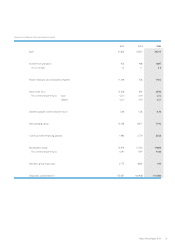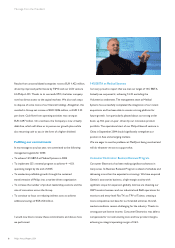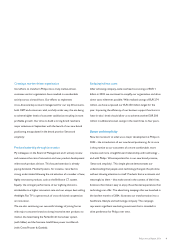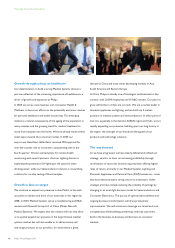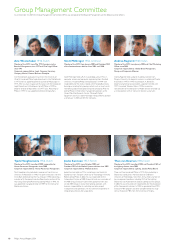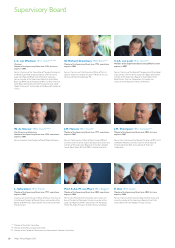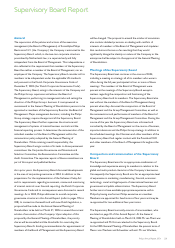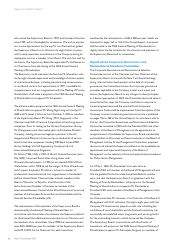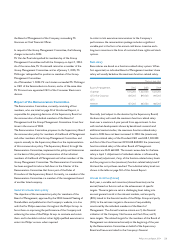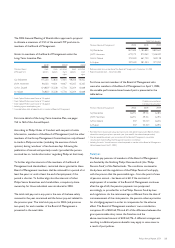Philips 2004 Annual Report Download - page 16
Download and view the complete annual report
Please find page 16 of the 2004 Philips annual report below. You can navigate through the pages in the report by either clicking on the pages listed below, or by using the keyword search tool below to find specific information within the annual report.On the basis of risk assessments, product division and business
management determine the risks related to the achievement of
business objectives and appropriate risk responses in relation to
the respective business processes and objectives. To ensure
compliance with laws and regulations, as well as with the
Company’s norms and values for ‘doing business’, rules are laid
down in the Philips General Business Principles and enforced by a
global system of Compliance Officers. The Philips General
Business Principles include a Financial Code of Ethics.
Internal auditors monitor the quality of the business controls
through risk-based operational audits, inspections of financial
reporting controls and compliance audits.
Internal controls over financial reporting
In view of internal and external developments, the Company
decided in 2002 to revisit and further strengthen the fundamentals
of its Business Control Framework. The first of these
developments is our drive to harmonize ERP systems, with SAP as
the leading standard, enabling us to replace time-consuming
manual controls with embedded, automated controls. The second
development was the introduction of the US Sarbanes-Oxley Act
and the related rules requiring, among other things, that
companies should assess and review their internal controls more
frequently, systematically document their findings and personally
involve managers in the monitoring process.
The Company rolled out a global Internal Control Standard (ICS)
on financial reporting, making use of its existing IT infrastructure
to support management in a quarterly cycle of assessment and
monitoring, creating full transparency of our control environment.
The Internal Control Standard has been deployed in 900 reporting
units, where business process owners perform approximately
90,000 controls each quarter. To support the roll- out, the
Company has embarked on an extensive training program.
Workshops have been organized for the Company’s Leadership
Group to familiarize the top 200 in product division and functional
domains with the concepts of the improved Business Control
Framework. In addition, some 60 training sessions have been
conducted in all regions, reaching controllers and managers in all
relevant units.
Risk management
The business-specific risks are managed mainly by the businesses
within the overall Business Control Framework. Treasury,
taxation and pensions are managed on Group level.
Our operations and our sales are located in almost every country
in the world, leading to a complex risk landscape. Furthermore,
the markets themselves have been very volatile and necessitate
constant and professional vigilance. As it is the Company’s
objective to minimize the impact on earnings and cash flow as a
result of movements in financial markets, Corporate Treasury has
issued policies and guidelines to that effect. The financial risks are
assessed continuously with the support of financial experts and
subsequently hedged in the most cost-efficient manner.
Corporate Fiscal develops tax policies and guidelines with regard
to international fiscal issues in accordance with international
standards. A review system is in place to safeguard proper
reporting of tax positions in the Philips accounts.
With pension obligations in more than 40 countries, the Company
has devoted considerable attention and resources to ensuring
disclosure, awareness and control of the resulting exposures.
Depending on the investment policies of the respective pension
funds and the size of their pension assets compared to their
pension obligations, developments in financial markets may have
significant effects on funded statuses and pension cost. To monitor
the corresponding risk exposure both for the respective pension
funds and for the Company, a Global Risk Reward Model for
pensions has been developed. The model, which covers around
95% of the total pension exposure, allows analysis of the
sensitivities to changes in equity market valuations and interest
rates and the determination of optimal combinations of expected
risks and returns for the respective pension funds.
Finance shared service centers
Our Global Service Units in Thailand, India and Poland are now
fully operational. They are key in supporting quality-improvement
and cost-reduction plans for finance operations. Processes are
being standardized globally, and each service center will very soon
be operating in a similar way. Global Service Units are helping us
to raise our competencies and skills in Finance & Accounting.
Overall we are pleased to see that these efforts are also helping to
strengthen our internal controls, through increased
professionalism and a deeper understanding of our processes.
15Philips Annual Report 2004


